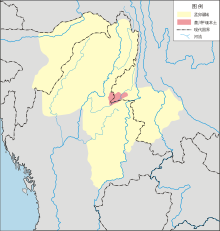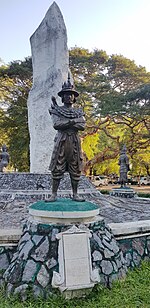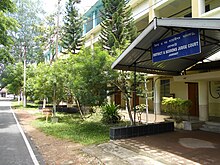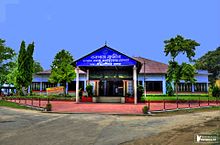Jorhat | |
|---|---|
Town | |
From top, then left to right:
Thengal Manor, Su-Ka-Pha Samannay Khetra, Jorhat Govt. Boys' Higher Secondary and Multi-Purpose School, Asam Sahitya Sabha headquarters, Night view of Baruah Chariali | |
| Nickname: City of Cultural Capital | |
| Coordinates: 26°45′N 94°13′E / 26.75°N 94.22°E | |
| Country | India |
| State | Assam |
| Region | Upper Assam |
| District | Jorhat |
| Zone | 3 (Central, East & West) |
| No. Of Wards | 19 |
| Established | 1909 |
| Government | |
| • Type | Municipality |
| • Body | Jorhat Municipal Board |
| • District Commissioner | Sri Pulak Kumar Mahanta, IAS |
| • Superintendent Of Police | Sri Mohanlal Meena, IPS |
| Area | |
| • Total | 72.8 km2 (28.1 sq mi) |
| Elevation | 116 m (381 ft) |
| Population | |
| • Total | 153,736 |
| • Density | 2,100/km2 (5,500/sq mi) |
| Demonym | Jorhatian |
| Time zone | UTC+5:30 (IST) |
| PIN | 7850XX |
| Telephone code | 0376 |
| Vehicle registration | AS-03 |
| Sex Ratio | 951 ♀️/ 1000 ♂️ |
| Climate | Cwa |
| Official Language | Assamese |
| Literacy Rate | |
| Lok Sabha Constituency | Jorhat |
| Vidhan Sabha Constituency | Jorhat, Titabar, Mariani, Teok |
| Website | jorhat |
Jorhat (/ˈdʒɔːrhɑːt/ JOR-haht) is a town and a growing urban centre in the state of Assam in India.[3][4][5]
Jorhat ("jor" means twin and "hat" means market) means two hats or mandis - "Masorhaat" and "Sowkihat" which existed on the opposite banks of the Bhugdoi river.

Jorhat was the last capital of the Ahoms which lasted for at least 37 years. This town was settled near the Dichoi river, and a number of market were set near Dichoi, such as Phukanar Hat and Mashar Hat, thus this place came to be known as Jorhat (twin- market).
During the period of Moamoria rebellion, Johat (then known Dichai) attained importance, with Ahom premier Purnananda Burhagohain encampment at Dichai fort. To keep out the Moamoria rebel intrusion he made the Bibudhi Garh (or the perplexing fort as called by the rebels). The Ahom capital was finally shifted in 1794 from Rangpur to here, which it remained till the fall of Ahom kingdom in 1838.
Many tanks were built around the capital city by the Ahom royalty such as Rajmao Pukhuri or Borpukhuri, Buragohain Pukhuri, Bolia Gohain Pukhuri, Kotoki Pukhuri and Mitha Pukhuri. This town was a flourishing and commercial metropolis.

The town was occupied by the Burmese Konbaung dynasty between 1817 - 1825. The Burmese left the commander Mingimaha Tilwa in charge of the area who appointed Jogeswar Singha as the new puppet King in 1821 in Jorhat.[6] Later when the deposed king Chandrakanta Singha tried to fight back, Bagyidaw (1819 – 1837), the seventh King of Burma sent the greatest of his generals Mingimaha Bandula with 20,000 troops[7] (including 10,000 Kamti Shan and Kachin levies who were chieftains of Mongkawng and Hukawng) who defeated Chandrakanta Singha at Mahgarh near Jorhat and reestablished Burmese authority in Assam. The defeat of Chandrakanta on June 12, 1822, mark the start of the Burmese rule in Assam.[8] and Burmese commander Mingimaha Tilwa was made the king. Maha Bandula then returned to Ava in Myanmar.
In 1885, a narrow-gauge railway, Jorehaut Provincial Railway, became operational. In time, this contributed to the rapid growth of the tea industry.[9]
Jorhat is located at 26°45′N 94°13′E / 26.75°N 94.22°E.[10] It has an average elevation of 116 metres (381 feet).
The municipality covers an area of 9 square kilometres (3.5 sq mi),[2] has 19 wards with a population of about 1.53 lakhs at present, with 72.8 square kilometres (28.1 sq mi) for master plan area.[11] The district spreads over 2,851 square kilometres (1,101 sq mi) and had a population of 870,000 according to a 1991 census. Population density at that time was 306 persons per square kilometre (793/sq mi). The sex ratio is 913 (913 females per 1000 males).
Jorhat Municipal Board (covering the out growth area) had a population of 1,26,736 as of the 2011 census.[12]
The average literacy rate of Jorhat in 2011 was 91.39%. Gender-wise, male and female literacy were 93.63% and 88.99% respectively, which is one of the highest in the state. The total literates in Jorhat were 182,600 of which male and female were 96,806 and 85,794 respectively.
Jorhat's sex ratio stood at 935 females per 1000 males, according to the Census 2011 Directorate.
Hindus were 87.49% of the population, while Muslims were 10.50% and Christians 0.62% of the population respectively.[13]
Scheduled Castes and Scheduled Tribes are 6.40% and 1.84% of the population respectively.[12]
Assamese is the predominant language and is spoken by 70.08% of the population, while Bengali was spoken by 12.27%. Hindi (11.60%) and Bhojpuri (1.01%) are spoken by migrants from the Gangetic plains, such as traders and labourers. Ethinic languages like Mising and Deori are also spoken by the respective ethnicity. Other small languages in the city include Marwari, Sadri, Santali, Sora and Odia which in total are spoken by 5.04% of the population.[14]
Jorhat is known as the Cultural Capital of Assam. It has rich contributions in the fields of arts, culture and tradition of the contemporary Assamese society. In 1896, Jorhat Theatre was established to perform cultural activities and dramas by some renowned people of the town. The Chandrakanta Handique Bhawan, the headquarters of Asam Sahitya Sabha was established in 1926. Jorhat has produced creative writers, historians and journalists. Birendra Kumar Bhattacharya, the first Assamese to win India's highest literature award, the Jnanpith Award, was from Jorhat.[15]
In 1935, the first Assamese daily newspaper Dainik Batori was published from Jorhat by Raibahadur Siva Prasad Barooah.[16][17] The daily newspapers which have Jorhat editions include Dainik Janambhumi, Amar Asom, Dainik Agradoot and Asomiya Khabar in Assamese, the Purbanchal Prohori in Hindi and The Telegraph in English. The Eastern Clarion was the first English daily published from the city, but it was ceased. Besides the dailies, a weekly newspaper Saptahik Janambhumi is also published from Jorhat. City Guide of Jorhat was the first yellow pages, published in July 1987. Jorhat has a radio broadcast station of All India Radio (AIR) located on the outskirts of the city at Garmur.

The District & Sessions Judge Upper Assam District Jorhat was created on 15 November 1948 and has been made permanent w.e.f the 1 April 1953. The first roll of honor of District & Sessions Judge of Assam Valley, Upper Assam Districts, Jorhat District was Mr. S.K Das, MA, BL. Presently, the territorial jurisdiction of the District is extended over 2(two) sub-divisions namely Majuli Sub-Division and Titabar Sub-Division. Altogether, the District & Sessions Judge and the Chief Judicial Magistrate comprise 15 courts staffed by Judicial Officers of various grades. The District & Sessions Judge together with the Chief Judicial Magistrate Court Complex, Jorhat is situated in the heart of the city. The Present District & Sessions Judge as the head of the establishment is Shri Mridul Kumar Kalita. The present Chief Judicial Magistrate, Jorhat, the head of all the Criminal Courts is Sri Vijay Kumar Singh.[18][19]
Jorhat Airport commonly known as Rowriah Airport, is located at Rowriah, a suburb of Jorhat, about 7 kilometres (4.3 mi) from the city centre.[20] The airport has daily flights connectivity to Kolkata, Delhi, Bengaluru and Guwahati operated by IndiGo. It is controlled by the Airports Authority of India.
The first rail connectivity of Jorhat began during British era in 1885, when Jorehaut Provincial Railway, a narrow-gauge railway services became operational.
Jorhat is served by Jorhat Town railway station[21] which lies on the Furkating-Jorhat-Mariani branch line of Tinsukia railway division. Mariani Junction railway station,[22] the major railway junction of the district is about 18 km (11 mi) from Jorhat. It falls in the Lumding-Dibrugarh section and is well connected to all the large cities of the country by long-distance express trains.
The Inter State Bus Terminus (ISBT) of Jorhat is at Kotokipukhuri, Tarajan. It provides connectivity to elsewhere in the state and the Northeast with regular buses from ASTC and private operators. Auto-rickshaws, local cabs and rickshaws are the main mode of public transport within the city.
The daily ferry services connect the Nimati ghat with Kamalabari and Aphalamukh in Majuli. The Neamati multimodal waterways terminal on Brahmaputra National Waterway 2 in Jorhat district is part of the Bharatmala and Sagarmala projects.[23]



Cinnamara[47]
Established in 1950, the multi-purpose Jorhat Stadium is the oldest stadium of Assam, which is mainly used for cricket and football.[57] It has hosted few Ranji Trophy matches. The prominent football tournament ATPA Shield held every year in this venue since 1955. Jorhat Town Club used the stadium as home ground for their home matches of Assam State Premier League. Other sporting venues near the stadium include JDSA Field, Kushal Konwar Indoor Stadium, Jorhat Swimming Society and Jorhat Tennis Club.[58] The historic sporting venue Jorhat Gymkhana Club known for the century old annual horse race called Jorhat Races, which began in 1877. It has a golf course and a cricket ground.[59]
Jorhat is part of Jorhat (Lok Sabha constituency).[60] Bharatiya Janata Party's Topon Kumar Gogoi the current Member of Parliament serving the 17th Lok Sabha from Jorhat, Assam. While Hitendra Nath Goswami of BJP is the incumbent MLA from Jorhat assembly constituency.[61]
((cite web)): CS1 maint: archived copy as title (link)
((cite web)): |author= has generic name (help)
((cite journal)): Cite journal requires |journal= (help)